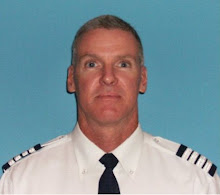Clear The Berm
Shortly after takeoff, the flight engineer announces “You're Clear The  Berm”. At that point, the aircraft survivability equipment is armed and the implication is we have left the secure airfield boundary and are now operating in unfriendly territory. The situation becomes fluid…the radios are busy, all eyes are outside the aircraft and the crew is on the look out for shooters, wires, flocks of birds and anything that looks out of the ordinary. The communication among the crew is direct and concise;
Berm”. At that point, the aircraft survivability equipment is armed and the implication is we have left the secure airfield boundary and are now operating in unfriendly territory. The situation becomes fluid…the radios are busy, all eyes are outside the aircraft and the crew is on the look out for shooters, wires, flocks of birds and anything that looks out of the ordinary. The communication among the crew is direct and concise;  “Wires 10 o’clock”, “Vehicle stopped on the road at 2 o’clock”, “People in the open at your 12 o’clock”. The pilot flying acknowledges each statement and often follows it up with evasive action. While flying low-level, the flight engineers are perched at the shoulder of each pilot…standing the entire day.
“Wires 10 o’clock”, “Vehicle stopped on the road at 2 o’clock”, “People in the open at your 12 o’clock”. The pilot flying acknowledges each statement and often follows it up with evasive action. While flying low-level, the flight engineers are perched at the shoulder of each pilot…standing the entire day.
In Iraq, the weather reporting is unrefined; the instrument flight structure used in poor weather conditions is lacking; and radio communication issues abound. The airspace is crowded with jets, helicopters, UAV’s and other airplanes. Confusion can quickly become the norm and being vectored for a mid-air is no longer a remote possibility. As a survival mechanism, the aircrews begin to view air traffic control (ATC) requests with a certain skepticism. The first time a crew takes fire while complying with an ATC request…like a 360 degree turn for aircraft spacing or a request to hold over an area pending arrival instructions…their perspective on ATC is forever changed. In those moments, your head begins to feel very large in the windscreen and your complexion seems to take on the color of a bull’s-eye.
(ATC) requests with a certain skepticism. The first time a crew takes fire while complying with an ATC request…like a 360 degree turn for aircraft spacing or a request to hold over an area pending arrival instructions…their perspective on ATC is forever changed. In those moments, your head begins to feel very large in the windscreen and your complexion seems to take on the color of a bull’s-eye.
When crossing the berm, our crews have put their faith into route selection, tactics, experience and in each other. The objective is to stay unpredictable in our methods…but always prepared for the unexpected. By combining discipline with a little luck, our ultimate goal is to complete the mission and have everyone make it back over the berm.
 Berm”. At that point, the aircraft survivability equipment is armed and the implication is we have left the secure airfield boundary and are now operating in unfriendly territory. The situation becomes fluid…the radios are busy, all eyes are outside the aircraft and the crew is on the look out for shooters, wires, flocks of birds and anything that looks out of the ordinary. The communication among the crew is direct and concise;
Berm”. At that point, the aircraft survivability equipment is armed and the implication is we have left the secure airfield boundary and are now operating in unfriendly territory. The situation becomes fluid…the radios are busy, all eyes are outside the aircraft and the crew is on the look out for shooters, wires, flocks of birds and anything that looks out of the ordinary. The communication among the crew is direct and concise;  “Wires 10 o’clock”, “Vehicle stopped on the road at 2 o’clock”, “People in the open at your 12 o’clock”. The pilot flying acknowledges each statement and often follows it up with evasive action. While flying low-level, the flight engineers are perched at the shoulder of each pilot…standing the entire day.
“Wires 10 o’clock”, “Vehicle stopped on the road at 2 o’clock”, “People in the open at your 12 o’clock”. The pilot flying acknowledges each statement and often follows it up with evasive action. While flying low-level, the flight engineers are perched at the shoulder of each pilot…standing the entire day.In Iraq, the weather reporting is unrefined; the instrument flight structure used in poor weather conditions is lacking; and radio communication issues abound. The airspace is crowded with jets, helicopters, UAV’s and other airplanes. Confusion can quickly become the norm and being vectored for a mid-air is no longer a remote possibility. As a survival mechanism, the aircrews begin to view air traffic control
 (ATC) requests with a certain skepticism. The first time a crew takes fire while complying with an ATC request…like a 360 degree turn for aircraft spacing or a request to hold over an area pending arrival instructions…their perspective on ATC is forever changed. In those moments, your head begins to feel very large in the windscreen and your complexion seems to take on the color of a bull’s-eye.
(ATC) requests with a certain skepticism. The first time a crew takes fire while complying with an ATC request…like a 360 degree turn for aircraft spacing or a request to hold over an area pending arrival instructions…their perspective on ATC is forever changed. In those moments, your head begins to feel very large in the windscreen and your complexion seems to take on the color of a bull’s-eye.When crossing the berm, our crews have put their faith into route selection, tactics, experience and in each other. The objective is to stay unpredictable in our methods…but always prepared for the unexpected. By combining discipline with a little luck, our ultimate goal is to complete the mission and have everyone make it back over the berm.



0 Comments:
Post a Comment
<< Home